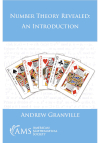- About MAA
- Membership
- MAA Publications
- Periodicals
- Blogs
- MAA Book Series
- MAA Press (an imprint of the AMS)
- MAA Notes
- MAA Reviews
- Mathematical Communication
- Information for Libraries
- Author Resources
- Advertise with MAA
- Meetings
- Competitions
- Programs
- Communities
- MAA Sections
- SIGMAA
- MAA Connect
- Students
- MAA Awards
- Awards Booklets
- Writing Awards
- Teaching Awards
- Service Awards
- Research Awards
- Lecture Awards
- Putnam Competition Individual and Team Winners
- D. E. Shaw Group AMC 8 Awards & Certificates
- Maryam Mirzakhani AMC 10 A Awards & Certificates
- Two Sigma AMC 10 B Awards & Certificates
- Jane Street AMC 12 A Awards & Certificates
- Akamai AMC 12 B Awards & Certificates
- High School Teachers
- News
You are here
Number Theory Revealed: An Introduction

Buy Now:
Publisher:
AMS
Publication Date:
2019
Number of Pages:
264
Format:
Hardcover
Price:
69.00
ISBN:
978-1-4704-4157-9
Category:
Textbook
The Basic Library List Committee suggests that undergraduate mathematics libraries consider this book for acquisition.
[Reviewed by , on ]
Nathan McNew
04/16/2023
In Number Theory Revealed: An Introduction, Andrew Granville presents a fresh take on the classic structure of a number theory textbook. While it includes the standard topics that one would expect to find in a textbook on elementary number theory, it is also filled throughout with related problems, different approaches to proving key theorems, and interesting digressions that will be of interest even to more advanced readers. At the same time, it assumes relatively little background — starting, for example, with an introductory chapter on induction — making it accessible to a wide audience.
This book is a shorter version of the longer book Number Theory Revealed: A Masterclass, which includes four additional chapters and many additional appendices for each of the thirteen chapters in this book. The book makes frequent references to sections only included in this longer version, which more motivated readers may find frustrating. However, the text and appendices included in this version of the text already include a variety of interesting twists on the more standard topics, such as an approach to the Euclidean algorithm using matrices and discussions of card shuffling and bouncing billiard balls.
The book draws heavily from the history of the subject, referring often to the original proofs, and gives special attention to the role of Gauss's Disquisitiones Arithmeticae as inspiration both for the book and the modern treatment of elementary number theory. The book also includes many modern developments as well, with an eye toward current research directions. References to the original papers in which these results appeared are included when they are particularly readable or of potential interest to the audience of this book.
Throughout, the book has a very conversational tone, asking motivating questions of the reader and starting with examples before giving proofs and rigorous definitions. In a similar vein, the text often includes asides discussing the merits of different approaches or proofs of certain results. Between these comments and the digressions, the reader feels like they can appreciate the author's personal connection to the material.
Numerous exercises are included, both mixed in the text and at the end of each chapter (and in the appendices as well). Hints are provided at the end for many of the exercises, especially ones in the text that are more integral to the development of the theory.
This would be a fun book for an elementary number theory class and is also an enjoyable read, though many readers should consider the longer version of the book.
Nathan McNew is an Associate Professor at Towson University.
See the publisher's website.
- Log in to post comments




